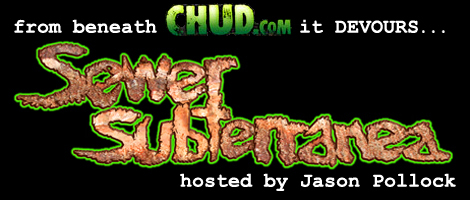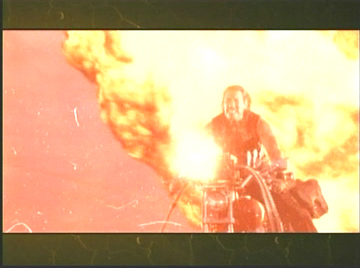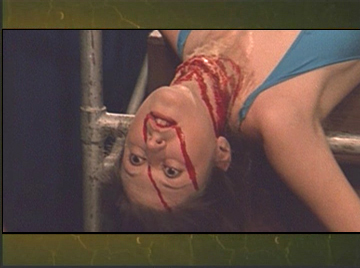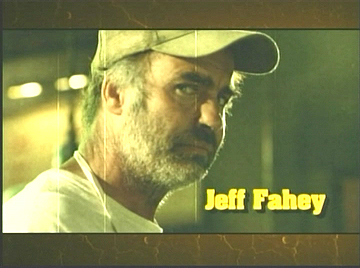
So by now, you’ve seen Grindhouse. Or, judging by the grosses – you haven’t. Maybe you’re on the fence. I want you off. I want you in the theater.
All the cool kids know that the best place for reviews on the web is CHUD.com (nobody goes to feardotcom.com anymore). And you’ve probably read the stellar Grindhouse reviews Devin, Russ, and Jeremy handed down. This is a movie that rewards a movie fan – and is best experienced with a room full of them. It’s peppered, layered, and slathered with references to a beloved and bygone era – and to many of the films that defined it.
This edition of the SS (as opposed to the version of the SS that traffics in Werewolf Women) will shed some light on the influences and references to be found in Grindhouse. As David Carradine once beseeched, “Won’t you join us??”
It?s a Small World after all…Motherfucker.
Grindhouse is clearly reverent of a time and place in cinematic history – but it also revels in creating a web of connections to both Tarantino and Rodriguez’s previous work. We’ll touch on that in greater detail later, but the concept is evident from the start, as the trailer for Machete unspools.

For those of you not familiar with the Spy Kids flicks, Uncle Machete is the name of Danny Trejo’s character in Robert Rodriguez’s family-friendly trilogy. In those films, Uncle Machete provides the children with their arsenal of non-lethal weaponry, and many a mention is made of his clandestine history. At one point Machete tells the children that he’ll never again manufacture weapons that kill – obviously an attempt to atone for his dark past.
Jeff Fahey pops up in the Machete trailer, in a role very similar to the character James Coburn played in The Hit List (not to be confused with Sir William Lustig’s bad-ass Jan-Michael Vincent vehicle Hit List) – a 1993 film that saw Jeff Fahey cast as a duped assassin.
Or maybe that should read – “A DOUBLE-CROSSED HITMAN WITH HIS BACK AGAINST THE WALL!!”
It bears mentioning that Rodriguez’s input feels less like the ’70’s exploitation staples the film claims to homage, and more like the ’80’s (Cannon) fodder provided by Menahem Golan and Yoram Globus. Much of the way Rodriguez stages his action would have been impossible to do on the cheap (or…at all) thirty years ago – there’s no way an Al Adamson motorcycle flick could have staged a stunt quite like the one wherein Machete is propelled by the concussive blast of a random explosion whilst firing away with the chopper-mounted minigun on loan from Predator‘s Jesse Ventura.
Rumors persist that Trejo will lead a DTV feature based on the trailer, and though the film’s sadly crapped box-office leaves much doubt as to the future of these spin-off projects, one hopes Machete can make it to shelves…
…and that the Fahey villain retains Sho Kosugi as an enforcer.
Nightmare Planet
The obvious influences on Planet Terror are Dan O’Bannon’s Return of the Living Dead (in both films, the military is responsible for the release of a toxin that turns the populace into not-quite-traditional zombies), and James Cameron’s Terminator (both of those films feature a female lead who grows into an action heroine via the urging of the male lead – and both of them are chock full o’ Michael Friggin’ Biehn).
Of course, the not-so-obvious inspiration for Planet Terror would be the 1980 Umberto Lenzi opus Nightmare City (aka City of the Walking Dead) – in which principled, bearded investigative journalist Hugo Stiglitz tries to warn the populace of an utterly generic metropolitan area about an invasion by irradiated zombie/vampire fiends inadvertently created by the government. The creatures in this film are lumpy, speedy, and smart enough to utilize weapons in their quest to drink the blood of the Solid Gold Dancers, among others.

Stylistically, Rodriguez’s influences can be boiled down to three filmmakers – Sam Raimi, John Woo, and John Carpenter. His Grindhouse effort takes these parallels – especially to Carpenter – farther than he has in his previous work. From the very first note that doesn’t accompany Rose McGowan’s gyrating ass, there’s an immutable John Carpenter influence to Rodriguez’s Planet Terror music cues – even the shock stings owe a dept to Carp.
The first visual Carpenter call-back hits early, as well. As the caravan of military vehicles leaves the base, eagle-eyed asswipes like me take notice that the words “Black Flight” are stenciled on the side of a Humvee. Black Flight was the name of the Special Forces unit Escape From New York’s S.D. Bob “Snake” Plissken served in.
Later – when a character…leaks from…a place (I’m trying to not be all spoilery here) the subsequent lump o’ goo takes on a life that owes its visual nature to Rob Bottin’s work on John Carpenter’s The Thing.
As previously mentioned, Tarantino and Rodriguez delight in playing in one another’s adjacent sandboxes. During a radio broadcast, a deejay dedicates a song to the beloved Jungle Julia. It’ll be an hour and change before you know who that is, but it’s one of the first instances of cross-pollination in the film. However, it is by no means the most substantial.

Michael Parks portrays salty Texas lawman Earl McGraw in From Dusk Till Dawn, Kill Bill, Planet Terror, and Death Proof.
How the hell does that work, exactly – especially when he dies in From Dusk Till Dawn?
This timeline supposes that the events of Kill Bill unfold in 2001 – when the cameras were originally supposed to roll. It also assumes you won’t think I’m the biggest dork alive for doing this.
1996: Earl McGraw – with deputy/Son #1 Edgar (played by Park’s real-life son James) in tow – investigates the grizzly execution-style killings at a wedding chapel in El Paso, Texas.
2001: Beatrix Kiddo emerges from her coma. Begins kill-crazy revenge rampage.
2001: Coalition forces engage Al-Qaida in Tora Bora. Lt. Muldoon (Angry Bruce Willis – in the Ed Harris role) kills Osama Bin Laden and is poisoned by DC2.
2006 (speculative): McGraw (joined again by “Son #1”) looks into a traffic “collision” (as per current law enforcement vocabulary guidelines, it is improper to refer to them as “accidents”) that he believes to have been intentionally caused by former Hollywood stuntman Mike McKay (Kurt Russell). McGraw is shown to be dismissive and hostile to a doctor on the hospital premises, one Dakota Block (Marley Shelton, who – when Drew Form and Brad Fuller buy those Re-Animator remake rights – must be cast as Meg Halsey. I’m just sayin’…).
2007: A small town outside of Austin, Texas is exposed to DC2 gas during a shady deal gone bad. Earl McGraw is asked by Sheriff Hague (Michael Biehn) to assist with maintaining order during the ensuing epidemic. McGraw is forced to kill his ailing wife after she shows the violent symptoms of DC2 poisoning.
The aforementioned Dr. Dakota Block arrives at the McGraw residence shortly thereafter, where it is revealed that they are father and daughter, and Earl’s previous disdain for the doctor is revealed to be paternal disappointment. Speculation abounds as to the catalyst – though I’d assume he’s angered by his daughter’s excruciatingly awful taste in women.
2007 (speculative): Earl McGraw is killed in the line of duty by Richie Gecko – which places the events of From Dusk Till Dawn in a future where George Clooney becomes a box office draw.
1985: Austrian rock singer Falco records?
Sorry.
Of course, none of that really washes anyway. Quentin Tarantino has stated that Reservoir Dogs, Pulp Fiction, and Jackie Brown all take place in the same “universe”, and that Kill Bill is a movie from that universe – like maybe Vincent and Jules would go see Kill Bill – but the events depicted don’t happen in their world. By sharing characters in Kill Bill and Planet Terror and Death Proof and From Dusk Till Dawn, all of these films could now belong to the same fictional movie world – and they’re all sort of…sequels and prequels to one another. Feel free to do your Michael Ironside impression now.
And now back to Planet Terror, with no further interruptions…

During the Assault on J.T. Hague’s (Jeff Fahey again – in a role that would have gone to Rory Calhoun once upon a time) Bone Shack, El Wray calls his wrecker “the Killdozer” – a reference to the seminal 1974 possessed construction equipment genre classic of the same name.
When club owner Skip (Skip Reissig) unleashes his rotor (not R.O.T.O.R.) attack on the DC2 creatures, it’s a full-on Army of Darkness deathcoaster redux.
The film ends as The Terminator does, with our heroine heading south of the border on her path with destiny. Rodriguez must have fought a mirror image of himself in a scrapyard whilst writing this ending – finally choking the version of him that wanted a small Mexican child to tell Rose McGowan that there was a storm coming…
Previews of Coming Attractions!
Two of explo-director Rino DiSivestro’s (aka Alex Berger) most well-known works are Deported Women of the SS and Werewolf Women. Hmm…
Mush the two together and whaddya got?! Werewolf Women of the SS!
The usual suspects show up in Rob Zombie’s homage to the Nazi Concentration Camp genre. (Yeah. Seriously. Don’t know if you know this – but there’s a genre). Tom (Henry) Towles, Bill (Texas Chainsaw 2) Moseley, Udo (Andy Warhol’s Dracula) Keir – the casting itself is a reference to B-Movie history.
B-movie/D-cup vixen Sybil Danning appears as a terrifying Teutonic twin to Sherri Moon Zombie in the piece. Danning played a werewolf queen in Howling II – linking her to a lycanthropic legacy. And maybe she looks a little Dyanne Thorne…

Nicholas Cage pops up as Sax Rohmer’s Fu Manchu. This seems entirely incongruous – unless you consider the fact that B-auteur Jess (Vampyros Lesbos) Franco tackled the character twice. There’s no way Mister Zombie isn’t completely in love with Jesus.
Conveniently Located Near This Theater…
Mr. Wizard was very important to me growing up. The guy was a top scientist, and I learned a lot under his tutelage. One of the things he taught me was that the food in television commercials is seldom real. The camera does horrible things to actual food, and nowhere in the history of cinema is this more evident than in the Acuna Boys restaurant commercial.
An Acuna Boys beverage makes an appearance a few minutes later in Tarantino’s Death Proof – and if you give the logo a look, the brothers’ names appear under their silhouettes. Two of them are T-Bird and Automatic Slim. Reference!
In this case – it’s to Rolling Thunder, the John (Out For Justice) Flynn (God rest ‘im – as he passed earlier this month) post-Vietnam revenger written by Paul Schrader and starring William Devane. QT is a big fan of this cool little film, as evidenced by the fact that his one-time Miramax-funded distro shingle shared the title.
If you’re thinking…about reading this paragraph…
Let’s let Edgar Wright explain Don’t:
“It’s very much in the vein of…Mario Bava, or Argento – with a little bit of Legend of Hell House mixed in. The main thing is that it’s one of those European trailers, where the European horror films were kind of like…re-titled in the States to give them a more sensationalist title. You watch the trailer and the voice-over is all about spin, and it’s just like…’I have…no idea…what that film is about!’ There’s no dialogue from the film – just that voice-over…
‘If you’re thinking…about seeing this film alone…‘”
Wright perfectly captures the early/mid-seventies vibe that came with trying to fit the square peg of oblique foreign horror into the round hole of American distribution (the trailers would try so hard to hide the foriegn pedigree from an audience). The fonts he uses…the flawlessly executed voice-over (by Arrested Development‘s Will Arnett)…the awesome Giallo imagery – featuring a demented man-child (no doubt hidden away by Daria Nicolodi), people with cataracted white eyes and way bright blood, creepy/floaty women – married to the Hammer/Amicus vibe (the production company name is Ichorus) – To me – this is the trailer that needs to become a feature.
The question remains – before it was re-titled for Western audiences, what was it called??
All Will Be Carved.
Eli Roth’s take on the holiday-themed slasher flick boom in the early ’80’s is pretty much textbook. The post-production zoom (when we freeze-frame on Roth’s head, then slowly push-in on the image)…the ominous yet detached voiceover – it’s all there. Rumor has it that this is the trailer closest to actual feature production, and the concept could exist as a stand-alone slasher parody…who knows? Perhaps we’ll fear “The Pilgrim” soon enough.
White Line Fever…White-Knuckle TERROR! Death Proof – Quentin Tarantino’s end of the double-featured debauchery – is really light on directly referencing any one film in terms of look or narrative – instead focusing on the feel of the films it’s emulating.
Death Proof – Quentin Tarantino’s end of the double-featured debauchery – is really light on directly referencing any one film in terms of look or narrative – instead focusing on the feel of the films it’s emulating.
The film is made to look as though it was originally titled Quentin Tarantino’s Thunder Bolt. The white-on-black alternate title card is a reference to the fact that many exploitation films were re-released to different territories under different titles, regardless of whether they were successful or not – and usually because they weren’t. If the movie bombed, the distributor would cut a new trailer, this time playing up a different element of the film, then retitle and re-release it to the same theaters it died in a few months ago (based on the reputation of our friends at The Weinstein Company, it’s no surprise that Harvey Weinstein has stated that he’s considering doing just that with Grindhouse).
Structurally, Death Proof plays out a lot like a low-budget 70’s exploitation flick insomuch as a disproportionate amount of the running time is spent on set up/exposition, and there is very little action. Many B-films – even beloved ones – are tedious affairs because of this economically forced reality. Tarantino is, of course, known for writing stylized and comical dialogue, so these “recitative” passages are entertaining as well as being crucial to character development.
Which is not to say there aren’t a few references – the hood ornament on Stuntman Mike’s Nova is a replica of an ornament on display in Sam Peckinpah’s Convoy.
Jungle Julia’s Win-a-Lapdance-From-Butterfly poem is verse from Robert Frost (somehow I knew that without “Googling” it. What’s up with me?) – but it was also used in Don Siegel’s Telefon to trigger behavior slightly more deadly than a lapdance from Vanessa Ferlito (who finally gets her close up in Spider-Man 2.1)?but only slightly, only slightly less?
 Kim, Abby, Zoe, and Lee spend time riding around in Eleanor – Toby Haliki’s yellow Mustang from the original Gone in Sixty Seconds.
Kim, Abby, Zoe, and Lee spend time riding around in Eleanor – Toby Haliki’s yellow Mustang from the original Gone in Sixty Seconds.
Then there is the conversation in the diner between the second group of girls that is shot almost exactly like the Reservoir Dogs Like a Virgin/”I Don’t Tip” sequence, with the spinning camera here revealing that Stuntman Mike is close by (though it would have helped if he payed attention to the conversation the women were having – he could have targeted a group of Avon reps instead and saved himself some trouble).
My absolute favorite reference in Death Proof isn’t a film reference at all. It’s Rosario Dawson sticking her head out the window and telling Royal Pain, “Hey good lookin’ – we’ll be back to pick you up later!”
It’s a reference to Ronco’s Mr. Microphone – a cheap plastic mic with a weak-looking wire hanging out of the bottom that took about three seconds to fall off. Mr. Microphone allowed you to tune your FM radio to an unused spot on the dial (which required more wrist-born subtlety than a lifetime as a safecracker) and broadcast from it.
 In the ancient commercial (I must have been about four years old), a carload of guys pulls up alongside a couple of satin short-shorts clad disco sloots and dispenses with the immortal line. Subsequently, I’ve used “Hey good lookin’ – we’ll be back to pick you up later!” (sadly, without the benefit of a Mr. Microphone) about a million times in my life, to the chagrin of pretty much everyone. It’s highly amusing that the sort of behavior depicted as “good clean fun” in a national television spot some thirty years ago is the sort of behavior that would get you a “good clean sexual harassment lawsuit” today.
In the ancient commercial (I must have been about four years old), a carload of guys pulls up alongside a couple of satin short-shorts clad disco sloots and dispenses with the immortal line. Subsequently, I’ve used “Hey good lookin’ – we’ll be back to pick you up later!” (sadly, without the benefit of a Mr. Microphone) about a million times in my life, to the chagrin of pretty much everyone. It’s highly amusing that the sort of behavior depicted as “good clean fun” in a national television spot some thirty years ago is the sort of behavior that would get you a “good clean sexual harassment lawsuit” today.
Death Proof’s “Freeze-Frame and Super Up” ending is, in all probability, a reference to about six hundred different old-school martial arts films. I’d tell you which one it made me think of specifically – but I’m preparing a more in depth look at it for a future Subterranea installment. Stay tuned. We’ll be back to pick you up later.
When next we descend…we’ll take a look at a film that will make you stand up and shout, “I AM PROUD TO BE A BLACK MAN!“
CHUD’s Sewer Subterranea wants your films!
Send your flicks to:
CHUD Sewer Subterranea
PO BOX 967
Chesterton, IN 46304
E-Mail Sewer Subterranea at SewerSubterranea@hotmail.com
Visit Sewer Subterranea at MySpace